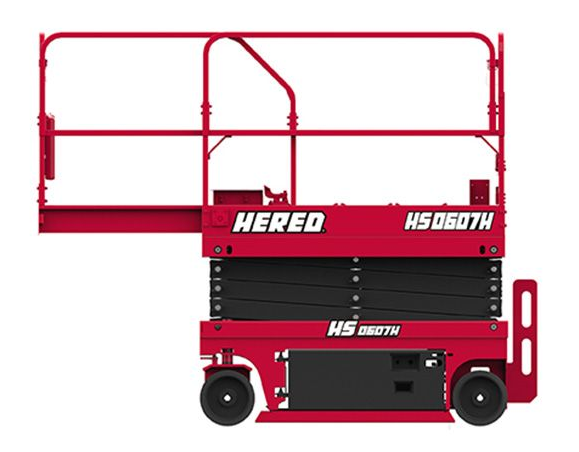Hydraulic Scissor Lifts: Elevating Efficiency and Safety
Hydraulic Scissor lifts are essential machinery widely used across various industries due to their remarkable ability to lift workers and materials to elevated workspaces. These versatile lifting devices utilize hydraulic systems to efficiently and safely reach heights that would otherwise be challenging or hazardous. In this article, we’ll explore the world of Hydraulic scissor lifts, covering their operation, types, benefits, applications, selection factors, maintenance, and top manufacturers.
OPERATING PRINCIPLE
HYDRAULIC SYSTEM
At the core of a hydraulic scissor lift is a hydraulic system consisting of several key components. A hydraulic pump, usually powered by electricity, generates hydraulic pressure. This pressure is transmitted through hydraulic lines to a hydraulic cylinder. As pressure builds in the cylinder, it extends, causing the scissor legs to open and raise the platform. To lower the platform, hydraulic pressure is gradually released, allowing the scissor legs to retract.
COMPONENTS OF A HYDRAULIC SCISSOR LIFT
- Hydraulic Pump: The power source for the hydraulic system that pressurizes the hydraulic fluid.
- Hydraulic Cylinder: Extends or retracts with changes in hydraulic pressure, driving the movement of the scissor legs.
- Scissor Legs: Interconnected metal struts arranged in a crisscross pattern, responsible for the vertical movement of the platform.
- Platform: The elevated work area that supports workers or materials, often featuring guardrails for safety.
- Base: A stable foundation that supports and guides the movement of the scissor legs.
- Power Source: Scissor lifts may be powered by electricity, diesel, or compressed air, depending on the model.
- Down Valve: Regulates the speed of platform descent.
- Flow Control Valve: Manages the flow rate of hydraulic fluid, controlling the speed of ascent and descent.
TYPES OF HYDRAULIC SCISSOR LIFTS
Hydraulic scissor lifts come in various types, each suited to specific tasks and settings. Choosing the right type is essential to ensure efficiency and safety for any application.
INDOOR VS. OUTDOOR MODELS
Hydraulic scissor lifts are often categorized by their intended environment—indoor or outdoor use. Indoor models are generally powered by electricity and are best suited for smooth, level surfaces. Outdoor models, typically diesel-powered, are designed to handle rougher terrains and withstand exposure to outdoor elements.
ELECTRIC VS. COMPRESSED AIR POWERED
Another key difference is the power source. Electric hydraulic scissor lifts are ideal for indoor use, offering quiet, emission-free operation. Compressed air-powered models, preferred in environments requiring minimal emissions and maintenance, use clean air pressure, making them an eco-friendly choice.
APPLICATIONS OF DIFFERENT TYPES
The choice of model and power source heavily influences the lift’s applications. Indoor models are commonly used in warehouses, manufacturing facilities, and maintenance tasks within buildings. Outdoor models are suited for construction sites, infrastructure projects, and other outdoor tasks requiring durability and mobility.
ADVANTAGES OF HYDRAULIC SCISSOR LIFTS
Hydraulic scissor lifts bring numerous benefits, making them essential tools in many industries.
ENHANCED SAFETY
Safety is critical when working at heights, and hydraulic scissor lifts provide a stable and secure platform that minimizes the risks associated with ladders or makeshift scaffolding. Many models also feature built-in safety mechanisms, including guardrails and emergency stop buttons, further enhancing worker protection.
VERSATILITY IN APPLICATIONS
The versatility of hydraulic scissor lifts is a significant asset. Suitable for a wide range of tasks—from maintenance and repair to material handling and construction—they offer adjustable height and load capacities, making them ideal for various work environments and requirements.
ENERGY EFFICIENCY
Electric-powered hydraulic scissor lifts are energy-efficient, reducing operational costs. They use less power than many other lifting machines, making them an economical choice for extended use.
SMOOTH AND PRECISE OPERATION
Hydraulic scissor lifts provide smooth, controlled elevation, allowing for precise positioning of workers and materials. This accuracy improves both work quality and productivity, particularly in tasks that require careful placement and attention to detail.
COMMON APPLICATIONS
Hydraulic scissor lifts are utilized across various industries, thanks to their versatility and safety features.
CONSTRUCTION INDUSTRY
In the construction sector, hydraulic scissor lifts are essential for tasks such as installing fixtures, painting, and accessing elevated work areas. Their mobility and stability make them invaluable tools on job sites.
WAREHOUSE AND STORAGE FACILITIES
In warehouses, scissor lifts are instrumental in stacking and retrieving items from high shelves. They enhance vertical space utilization and promote efficient inventory management.
MAINTENANCE AND REPAIR TASKS
Maintenance teams rely on hydraulic scissor lifts for various tasks, from changing light fixtures to conducting equipment repairs. Their stability and adjustable height make them ideal for accessing hard-to-reach areas.
MANUFACTURING AND PRODUCTION
In manufacturing, hydraulic scissor lifts enhance efficiency by allowing workers to reach elevated workstations and move heavy materials. They contribute to streamlined workflows and improved productivity.
CONSIDERATIONS FOR CHOOSING HYDRAULIC SCISSOR LIFTS
Selecting the appropriate hydraulic scissor lift involves several important factors to ensure that the equipment meets specific job requirements.
WORKING HEIGHT REQUIREMENTS
Determining the necessary working height is crucial. Hydraulic scissor lifts are available in various height capacities, and selecting the right one ensures that workers can safely access their designated work areas.
WEIGHT CAPACITY
Evaluating the lift's weight capacity is essential. Overloading a scissor lift can jeopardize safety and functionality. It's important to account for the combined weight of workers, tools, and materials on the platform.
TERRAIN AND ENVIRONMENT
The work environment significantly influences the choice between indoor and outdoor scissor lifts. For outdoor applications, models with rugged tires and diesel power may be required to effectively navigate uneven terrain.
MAINTENANCE AND SERVICE NEEDS
Consider the maintenance requirements and the availability of service support for the chosen hydraulic scissor lift. Regular maintenance is vital for ensuring the equipment's longevity and safety.
CONCLUSION
Hydraulic scissor lifts are vital tools across various industries, providing a safe and efficient way to access elevated workspaces. Understanding their principles, types, advantages, and applications is key to selecting the right lift for your specific needs. Furthermore, proper maintenance and strict adherence to safety protocols are essential to ensure the longevity and safety of these valuable machines. With numerous leading manufacturers offering a range of options, hydraulic scissor lifts continue to be indispensable assets for businesses looking to enhance efficiency and safety.





